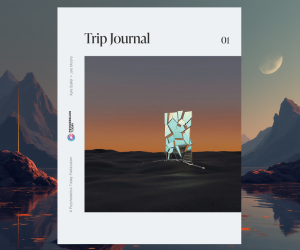So, you’ve had a psychedelic experience. And somewhere within the sensory avalanche, the perplexing interior narrative, and avoiding looking at your own face in the bathroom mirror, you (gasp!) may have actually learned something. But what comes next? How can you ensure to take the insights you gathered and apply them to your life? Enter psychedelic integration.
What is Psychedelic Integration?
The word ‘integration’ comes from the Latin word ‘integrare,’ which means to make whole or begin again. It also has French roots, from the word ‘intégration,’ which speaks to ‘bringing together parts of a whole.’
While the psychedelic community has yet to uniformly align on a single definition for integration, we can begin to understand it by acknowledging that psychedelics can help disrupt and loosen our rigid personality structures and long-held beliefs. Integration is about finding a middle ground, fixing the tears in our narratives, and becoming whole again.
Sounds simple, right? Simple, yes. Easy, maybe not. Psychedelic integration is both passive and active. It takes time, willingness, and effort to work through and re-live a psychedelic experience within the natural mind. It can involve taking a thorough inventory of the mind, body, and spirit, and challenging oneself to dig deep, get uncomfortable, and sometimes, make big changes.
But don’t panic. Integration is an extremely personal process and doesn’t look the same for everyone. Before getting started, get grounded, give yourself permission to take your time, and treat yourself with love, compassion, and patience.

Document Everything
Someone I used to work with is fond of saying “it doesn’t exist if it isn’t written down.” And while, for our purposes, he uses it in terms of project management, the same is true for psychedelic integration.
As soon as you’ve had a little breathing room from the most intense part of the trip – either before the psychedelic substance has worn off, or a few days after – begin journaling. Writing or recording the parts of the experience that stood out to you is a great place to start while the memory is fresh in your mind.
Whether in a blank notebook, or an intentionally designed psychedelic Integration Workbook, capturing those fleeting thoughts and feelings is often considered a foundational step in psychedelic integration. If a blank page feels a little daunting, check out our comprehensive guide to integrating psychedelic experiences, including meditation prompts, structured journaling exercises, and goal planning.

Find Someone to Listen
After a profound psychedelic experience, it’s often helpful to share your story with someone. Whether a therapist experienced in psychedelic integration, a trusted friend, or a member of a psychedelic community, finding a non-judgmental person to hold space for you is important.
The act of verbalizing your experience can help in processing and understanding it on a deeper level. Your experience may have included some anxiety, depression, and discomfort. It’s crucial to find a person who is open-minded (and did we mention, non-judgmental?), allowing you the space to explore your thoughts and feelings without steering them in any particular direction.
If your resources are limited, or there just isn’t anyone in your circle who fits the bill, consider contacting Fireside Project, a free helpline for peer support before, during, and after a psychedelic experience.
“(The volunteers) come to the experiences having had their own experiences, and desiring to hold space for others as they navigate their experiences and navigate their processing afterwards. They’re not doing therapy. They’re not diagnosing. They’re really with the person (the caller, the texter) as somebody who gets it,” Fireside Project founder Hanifa Washington told Psychedelics Today.
Depending on the intensity of your experience and the state of your well-being in the aftermath, finding a trained professional or a doctor may be necessary – especially if you’re in distress.

Do Your Homework
Psychedelic integration also involves educating yourself about the psychedelic experience. Dive into books, scientific research, and personal accounts that discuss psychedelics and their effects on the mind and body. Understanding the psychological, neurological, and spiritual aspects of psychedelics can provide a richer context to your experience.
To really dig into your integration, consider taking an online course. Navigating Psychedelics: Lessons on Self-Care and Integration was designed so you can learn at your own pace, with lessons on how to get the most out of your experience and integrate psychedelic experiences into your daily life.
These days, there is more psychedelic information available to curious people than ever before. While there can be a lot to wade through, it’s best to find a format that’s easy and compelling to digest. This knowledge can help in recognizing common themes and lessons that emerge in psychedelic experiences. Knowledge is power, and there’s a lot of it out there for you to discover.

Take Care of Yourself
Physical health plays a significant role in psychological and spiritual well-being, especially after a psychedelic experience. And if you’ve just had one, your body might have gone through the ringer.
Ensure you’re taking care of your body through proper nutrition, adequate sleep, and regular exercise. Activities you enjoy, like yoga, art, meditation, and nature walks can also be beneficial, helping to ground your experiences in the physical world. Remember, a healthy body is crucial for a healthy mind. Though you may often hear about mental and physical health discussed separately, they are one in the same.

Find the Others
Outside of a therapist or coach, connecting with others who have had similar experiences can be incredibly beneficial for psychedelic integration. Look for community groups, workshops, or online forums where people discuss their psychedelic experiences and integration processes. Sharing with and learning from others can provide different perspectives and insights, and also remind you that you are not alone in this journey.
And even if, for example, you’ve taken psilocybin, don’t discount the experiences of those who have used other substances, from 5-MeO-DMT to ketamine (and all substances in between). While the substances and effects on the body and mind may differ, many of the feelings that can arise and the outcomes can be eerily similar. Finding commonality with many others who use psychedelics for healing and betterment can offer support, understanding, and camaraderie as you navigate your own integration journey.

Don’t Overthink It
The morning after my first ayahuasca experience, I woke up to a text from a friend that read:
Try to love the questions themselves as if they were locked rooms or books written in a very foreign language. Don’t search for the answers, which could not be given to you now, because you would not be able to live them. And the point is, to live everything. Live the questions now.
I didn’t fully embrace the sentiment of this quote, originally written by Austrian author Rainer Maria Rilke, until much later. My friend was gently urging me to avoid trying to decode the ayahuasca experience too quickly. I didn’t take this advice, and by the time I landed back in Canada, I decided the medicine was, without question, urging me to live with more gratitude. Maybe so, but maybe that wasn’t quite everything I could have learned, or even the most profound. Because I stopped asking questions, I closed the door to new insights.
“How beautiful that we have this access to deep knowledge of the universe through us, but we have to be quiet. We have to be quiet to hear the whispers of the heart. And when you become quiet, the whispers of the heart become louder and they start filling you in. Then you have to start believing it,” Dr. Michael Sapiro told Psychedelics Today.
Sometimes, psychedelic experiences can be colossal, endless, and enlightening.
And sometimes, they can also be underwhelming, unremarkable, and even boring. Resist the urge to define the ‘why’ too quickly after the substance has worn off. Take a beat, unpack it, and let it marinate in your mind for a bit before concluding its significance – there may be more (or less) there than you think.
One Step at a Time
Choosing to take psychedelics can be transformative, opening doors to new perspectives and deeper understanding of oneself. But remember, the true journey begins with integration — weaving these profound experiences into the tapestry of your daily life.
While some may choose to take it slow and make the journey completely personal, others might feel inspired to integrate psychedelic work into their professional lives. If that’s you, consider becoming professionally trained before engaging in psychedelic practice with others.
As you navigate this path, cherish the insights, embrace the challenges, and remember that psychedelic integration is meant to be a journey, not a destination.
Eager to learn more? Check out our comprehensive self-paced course, Navigating Psychedelics: Lessons on Self-Care and Integration for your complete guide to understanding and integrating the psychedelic experience.



